Brushing/Speedy Cutting
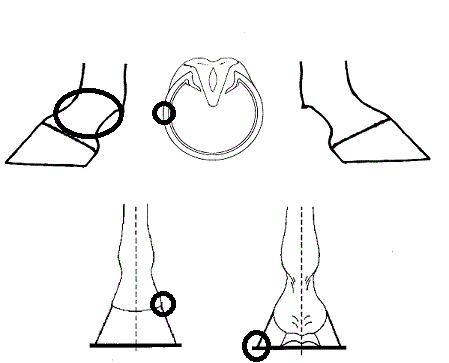 Brushing is the inside hoof catching the opposite leg or fetlock area. Often caused from a narrow base conformation or toe out causing the legs to move closely to each other during flight. This occurs on the front limbs and causes scuffs or grazes. Speedy cutting is the same thing at speed causing more severe injury. For narrow base horses strengthening the horse works, as the chest gets wider with work the narrow base goes away. Speedy cutting shoes can be use or boots to avoid the shoe striking the leg which is causing the damage.
Brushing is the inside hoof catching the opposite leg or fetlock area. Often caused from a narrow base conformation or toe out causing the legs to move closely to each other during flight. This occurs on the front limbs and causes scuffs or grazes. Speedy cutting is the same thing at speed causing more severe injury. For narrow base horses strengthening the horse works, as the chest gets wider with work the narrow base goes away. Speedy cutting shoes can be use or boots to avoid the shoe striking the leg which is causing the damage.
Cross firing
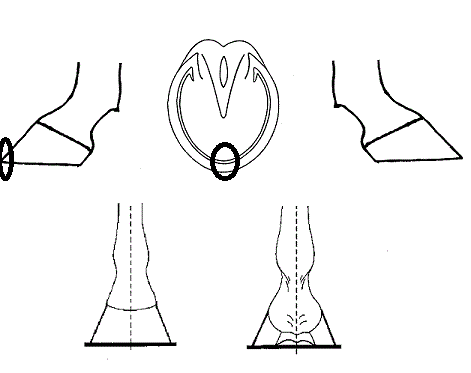
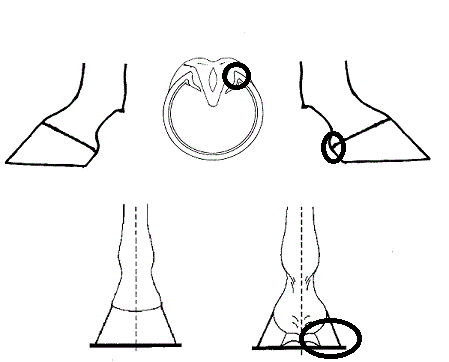 Cross firing is interference from one hind leg to the opposite front leg, often seen in trotters and pacers as they work on a two lead movement. Poor conformation whilst doing this will improve chances of cross firing. Such as sickle or cow hocked. Lack of muscle or balance and control will cause the horse to cross fire as well as if the rider or trainer teaching the horse is poor. Can be seen from the damage to the inside aspect of the front hoof, but must be viewed to make sure it is cross firing not just over reaching. X-rays should be taken of the hock and any issues that can be solved via shoeing to help support it will help the cross firing. Trimming level making sure there is level foot fall will massively help keep the limb straight as it moves.
Cross firing is interference from one hind leg to the opposite front leg, often seen in trotters and pacers as they work on a two lead movement. Poor conformation whilst doing this will improve chances of cross firing. Such as sickle or cow hocked. Lack of muscle or balance and control will cause the horse to cross fire as well as if the rider or trainer teaching the horse is poor. Can be seen from the damage to the inside aspect of the front hoof, but must be viewed to make sure it is cross firing not just over reaching. X-rays should be taken of the hock and any issues that can be solved via shoeing to help support it will help the cross firing. Trimming level making sure there is level foot fall will massively help keep the limb straight as it moves.
Forging
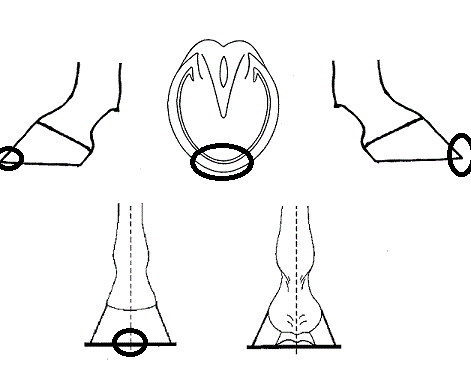
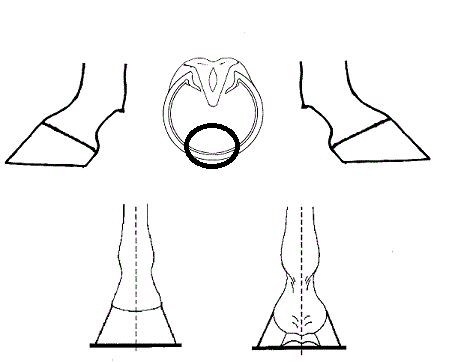 This is where the toe of the hind hits the sole of the front foot as it is lifting of the ground. Can be caused by being very short coupled, lack of break over in the fronts maybe caused by fatigue or poor riding. You will be able to hear the forging as its metal on metal hence its name. You can shoe the horse with rolled toes or quarter clips in front to help the break over meaning they get away quicker and don’t forge.
This is where the toe of the hind hits the sole of the front foot as it is lifting of the ground. Can be caused by being very short coupled, lack of break over in the fronts maybe caused by fatigue or poor riding. You will be able to hear the forging as its metal on metal hence its name. You can shoe the horse with rolled toes or quarter clips in front to help the break over meaning they get away quicker and don’t forge.
Overreaching
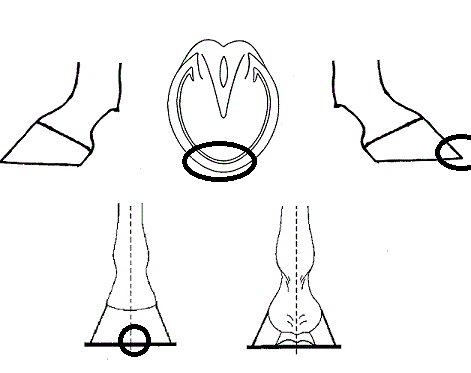
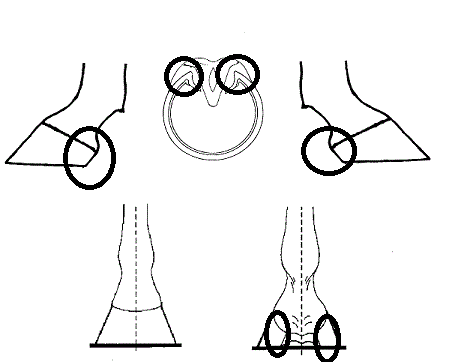 Over reaching is similar to forging in the sense it’s the hind foot catching the front. Rather than hitting the sole of the front it catches a heel instead causing an over reach on the heel area and a lost shoe. Signs of this are your lost shoe or a cut around the heel area. Generally caused by fatigue or lazy riding seen lots in the hunting season. To help this again give the fronts better break over with a rolled toe or quarter clips and try and get the toe back so there isn’t any sloping HPA present.
Over reaching is similar to forging in the sense it’s the hind foot catching the front. Rather than hitting the sole of the front it catches a heel instead causing an over reach on the heel area and a lost shoe. Signs of this are your lost shoe or a cut around the heel area. Generally caused by fatigue or lazy riding seen lots in the hunting season. To help this again give the fronts better break over with a rolled toe or quarter clips and try and get the toe back so there isn’t any sloping HPA present.
Puncture wounds
Causes of puncture wounds generally are nails or blackthorns, causing very immediate and severe lameness. Hot foot and obvious lameness will be present. Usually very obvious in the sole as the object will be still there or if it isn’t there will be a hole. In the frog if the object has come out the flexibility of it closes around it meaning no obvious signs are there. If suspected a vet should be called immediately, this is to assess angle and depth of object. This is to make sure what sensitive structures may be involved. Once object is removed a poultice should be applied to draw out any infection. And if a severe wound is there than a shoe with a hospital plate can be used to keep it dry and clean. Depending on what structures have been hit you would expect a full recovery without any much worry. However, if left untreated or structure like the pedal bone or Deep Digital Flexor Tendon (DDFT) are involved things may get very serious.
Thin soles
This is usually a genetic thing seen in thoroughbreds that are flat footed. Obvious to the touch as a squeeze with the thumb or hoof testers will create a very easy flexibility and usually a reaction from the horse. very little can be done, avoid taking out any sole when shoeing and advise the use of purple sprays and keeping the feet dry to insure it hardens up the sole.
Corns
Corns are a bruising or infection in the seat of corn area. Usually caused by short shoeing or leaving them to long between shoeing’s. This causes haemorrhaging in the area and often seen as bruising when easing the area out when trimming. 4 stages of corns are dry, wet, suppurating and septic pipe corn. Dry corns are commonly seen and simple supportive shoeing can be used, wide section used to take disperse weight and even something such as a bar shoe to spread the load even more can be used. Veterinary treatment may be needed in case of septic or suppurating corn as these will need fully digging out and flushing through, usually these infections blow out the hoof capsule as they travel up the horn tubles.
False quarter
False quarter is where the hoof at the quarter does not grow completely because of injury to the coronet. Seen as a shallow indent or crack coming down from the damaged area. Once damaged no treatment at present will fix this. A small crack will always be present but should cause little or no issue. Shoeing with a nice bit of support and possibly adding a clip to the shoe behind the quarter just to hold the hoof capsule together to avoid the crack opening up.
Thrush
Thrush is an anaerobic bacteria meaning it thrives in oxygen deprived places. So poor stable management is often key to this. Seen in the clefts of frogs and often deep set the frog will need to be trimmed right back and thoroughly cleaned out with hot salt water or hibby scrubbed and purple sprayed. The thrush is a foul smelling rot that is a black thick tar and thrives in dirty conditions. No vet treatment should be needed and prognosis is very good if management is just kept up.
Seedy toe
Is a separation of the hoof wall and laminae. The gap in between just crumbles away and dies and often leads to infection. Will need cleaning and digging out completely either by vet or farrier. Clean out thoroughly so air can get in and wash out daily with Epsom salts or iodine or what the vet suggests. Dry poultice and no turn out so nothing gets in it would be ideal. This should clear it up, often no lameness is ever seen and prognosis is very good.
White line disease
Similar to seedy toe in the way that is enters the hoof through cracks and separation of the hoof wall. Looking much the same as seedy toe as the crumbling effect takes place however there is no cure for this. The pathogens and bacteria that cause this disease cannot be killed. If caught early on then it can be dug out and the growth time isn’t too bad. However if left to long and the infection eats away at the stratum medium and deeper and deeper, then the cutting it out will be severe and growing the hoof back will take the best part of a year. Unfortunately this is the only thing to do as no chemicals we have can kill this bacteria off. Keeping horses feet well-trimmed to prevent the separation is the best way of avoiding this infection. Prevention is always better than cure. Despite being time consuming if the conditions are clean and you work with the farrier and vet then the prognosis is very successful.
Sand crack / hoof wall cracks
Cracks are a stress fracture from the hoof and are often caused by loading issues. Over grown feet or imbalance are generally the causes we see. Also damage to a papillae will cause a crack. If for any second the hoof doesn’t load properly and one papillae does not get the nutrients it needs through the blood then a crack shall appear. Sand cracks start at the top and grass cracks are from the bottom first. Trimming back and level achieving an even foot fall will relieve the stress and in time easy the cracks out. Quarter clips in front can cause the hoof to pinch if done poorly and can cause a sand crack in the toe. If kept on top off no serious damage should be done. If left the crack can pinch and start to tear the sensitive structures as well causing serious damage to sensitive structures and making lameness very present.
Hoof deformities (capsule distortion)
Hoof deformities are usually the result of genetics or an issue as a foal that isn’t really treated. When left alone at a young age the deformity will remain with the horse its whole life. Usually due to a loading issue meaning the hoof has to grow to compensate. Poor balance often being the catalyst. The treatment is to fix these problems very early on, if the hoof is kept in a good shape and balance is kept level. If this is done there is no reason for deformities to develop. If shoeing a horse that already has this then simply offering support to the affected area is most important. Get the foot level footfall and put the shoe where it needs to be rather than where the foot is.
